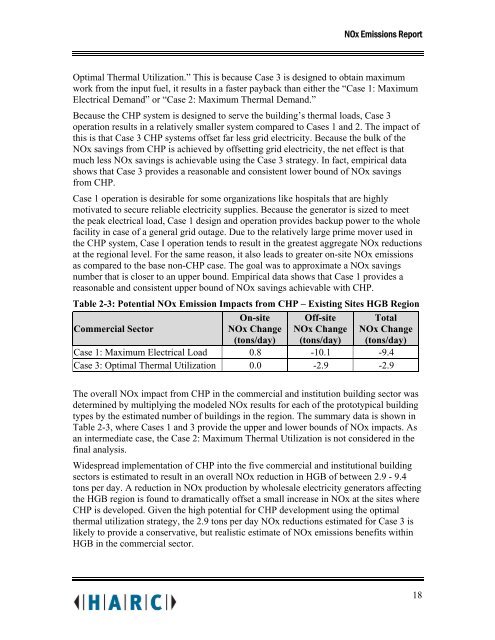NOx Emissions Impacts from Widespread Deployment of CHP in ...
NOx Emissions Impacts from Widespread Deployment of CHP in ...
NOx Emissions Impacts from Widespread Deployment of CHP in ...
Create successful ePaper yourself
Turn your PDF publications into a flip-book with our unique Google optimized e-Paper software.
<strong>NOx</strong> <strong>Emissions</strong> Report<br />
Optimal Thermal Utilization.” This is because Case 3 is designed to obta<strong>in</strong> maximum<br />
work <strong>from</strong> the <strong>in</strong>put fuel, it results <strong>in</strong> a faster payback than either the “Case 1: Maximum<br />
Electrical Demand” or “Case 2: Maximum Thermal Demand.”<br />
Because the <strong>CHP</strong> system is designed to serve the build<strong>in</strong>g’s thermal loads, Case 3<br />
operation results <strong>in</strong> a relatively smaller system compared to Cases 1 and 2. The impact <strong>of</strong><br />
this is that Case 3 <strong>CHP</strong> systems <strong>of</strong>fset far less grid electricity. Because the bulk <strong>of</strong> the<br />
<strong>NOx</strong> sav<strong>in</strong>gs <strong>from</strong> <strong>CHP</strong> is achieved by <strong>of</strong>fsett<strong>in</strong>g grid electricity, the net effect is that<br />
much less <strong>NOx</strong> sav<strong>in</strong>gs is achievable us<strong>in</strong>g the Case 3 strategy. In fact, empirical data<br />
shows that Case 3 provides a reasonable and consistent lower bound <strong>of</strong> <strong>NOx</strong> sav<strong>in</strong>gs<br />
<strong>from</strong> <strong>CHP</strong>.<br />
Case 1 operation is desirable for some organizations like hospitals that are highly<br />
motivated to secure reliable electricity supplies. Because the generator is sized to meet<br />
the peak electrical load, Case 1 design and operation provides backup power to the whole<br />
facility <strong>in</strong> case <strong>of</strong> a general grid outage. Due to the relatively large prime mover used <strong>in</strong><br />
the <strong>CHP</strong> system, Case I operation tends to result <strong>in</strong> the greatest aggregate <strong>NOx</strong> reductions<br />
at the regional level. For the same reason, it also leads to greater on-site <strong>NOx</strong> emissions<br />
as compared to the base non-<strong>CHP</strong> case. The goal was to approximate a <strong>NOx</strong> sav<strong>in</strong>gs<br />
number that is closer to an upper bound. Empirical data shows that Case 1 provides a<br />
reasonable and consistent upper bound <strong>of</strong> <strong>NOx</strong> sav<strong>in</strong>gs achievable with <strong>CHP</strong>.<br />
Table 2-3: Potential <strong>NOx</strong> Emission <strong>Impacts</strong> <strong>from</strong> <strong>CHP</strong> – Exist<strong>in</strong>g Sites HGB Region<br />
Commercial Sector<br />
On-site<br />
<strong>NOx</strong> Change<br />
(tons/day)<br />
Off-site<br />
<strong>NOx</strong> Change<br />
(tons/day)<br />
Total<br />
<strong>NOx</strong> Change<br />
(tons/day)<br />
Case 1: Maximum Electrical Load 0.8 -10.1 -9.4<br />
Case 3: Optimal Thermal Utilization 0.0 -2.9 -2.9<br />
The overall <strong>NOx</strong> impact <strong>from</strong> <strong>CHP</strong> <strong>in</strong> the commercial and <strong>in</strong>stitution build<strong>in</strong>g sector was<br />
determ<strong>in</strong>ed by multiply<strong>in</strong>g the modeled <strong>NOx</strong> results for each <strong>of</strong> the prototypical build<strong>in</strong>g<br />
types by the estimated number <strong>of</strong> build<strong>in</strong>gs <strong>in</strong> the region. The summary data is shown <strong>in</strong><br />
Table 2-3, where Cases 1 and 3 provide the upper and lower bounds <strong>of</strong> <strong>NOx</strong> impacts. As<br />
an <strong>in</strong>termediate case, the Case 2: Maximum Thermal Utilization is not considered <strong>in</strong> the<br />
f<strong>in</strong>al analysis.<br />
<strong>Widespread</strong> implementation <strong>of</strong> <strong>CHP</strong> <strong>in</strong>to the five commercial and <strong>in</strong>stitutional build<strong>in</strong>g<br />
sectors is estimated to result <strong>in</strong> an overall <strong>NOx</strong> reduction <strong>in</strong> HGB <strong>of</strong> between 2.9 - 9.4<br />
tons per day. A reduction <strong>in</strong> <strong>NOx</strong> production by wholesale electricity generators affect<strong>in</strong>g<br />
the HGB region is found to dramatically <strong>of</strong>fset a small <strong>in</strong>crease <strong>in</strong> <strong>NOx</strong> at the sites where<br />
<strong>CHP</strong> is developed. Given the high potential for <strong>CHP</strong> development us<strong>in</strong>g the optimal<br />
thermal utilization strategy, the 2.9 tons per day <strong>NOx</strong> reductions estimated for Case 3 is<br />
likely to provide a conservative, but realistic estimate <strong>of</strong> <strong>NOx</strong> emissions benefits with<strong>in</strong><br />
HGB <strong>in</strong> the commercial sector.<br />
18
















